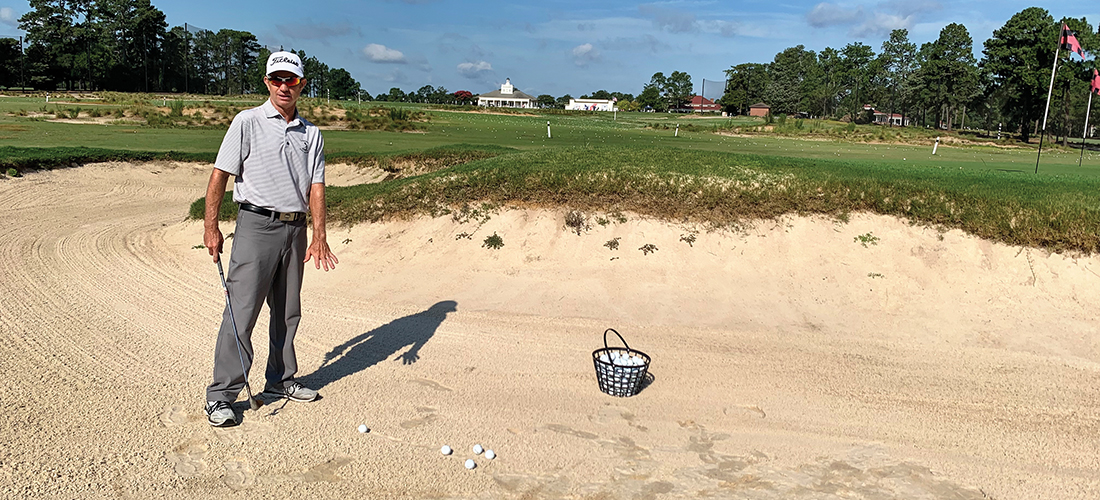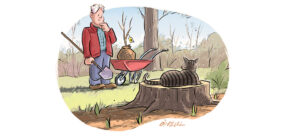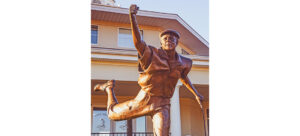
The Short List
Learning how to save shots, and your score
By Lee Pace
Kelly Mitchum is standing front-right of the 10th green at Pinehurst No. 4, his golf ball sitting slightly down in Bermuda rough, a bunker set between him and the putting surface. There’s a good 50 feet of green between the bunker and the cup.
“You can’t assume the only play is the lob wedge just because you’ve got to clear a bunker,” Mitchum says. “You’ve got plenty of room for the ball to run. And you’re going uphill, which will help slow it down.”
Later he’s standing to the right of the 16th green, his ball in light rough 30 feet from the green, with a slight upslope to the putting surface and a pin on the near side of the green.
“Could you putt this?” Mitchum asks. “Yes, you could. This course and No. 2 lend themselves to putting from off the green. Martin Kaymer won the 2014 U.S. Open putting from all over the place.
“The lower the shot, the safer the shot. Always look to go low first.”
Mitchum takes a close look at the pathway a putt would have to take along the turf. “But,” he says, pointing at the grass still glistening with some morning dew, “here I think there’s too much grass to putt through. And it’s a little wet.”
Instead, he takes his 54-degree wedge (the second-most lofted club in his bag, next to the 60-degree), chips the ball into the side slope, watches it bounce and pop up and land gently on the green, well within a putter’s length of making the putt for an up-and-down.
“This is the fun part of golf to me,” he says. “It’s creativity, imagination, strategy.”
Mitchum is leading our group in the Pinehurst Short Game Academy one Friday morning around several holes on the course to illustrate various scenarios golfers find themselves in within 100 yards of the green. The next day, we’ll spend time on course No. 2, the site of three men’s U.S. Opens, a fourth in 2024, and one women’s U.S. Open.
Over the course of two-plus days, Mitchum, the resort’s short-game expert, opens our eyes to a myriad of nuances in reading greens, executing short shots and managing our way around the greens.
To wit:
Grain: Light colored grass or darker?
Sand: Firm packed or fluffy?
Grass: Tight-clipped or longish? Dry or dew-covered?
Green slope: One degree? Two or more?
These questions and more, combined with technique and equipment, blend into the realm of the short game — pitching, chipping, putting and bunker play.
“The short game has been my passion,” says Mitchum, a 23-year veteran of the Pinehurst teaching staff. “Not being super long off the tee, it’s been my way of equalizing and giving me a chance against guys longer off the tee.”
Mitchum went to Pinecrest High School, played golf at N.C. State, winning the 1991 ACC title, and won the 1993 North and South Amateur. He tried the professional tours for four years and then joined the Pinehurst golf staff in 1998, and while working the resort’s golf schools and giving individual lessons, has found time to play in four PGA Championships and multiple PGA Tour events that come through the Carolinas.
He approached Eric Alpenfels, the resort’s director of golf instruction, in 2017 with the idea of creating a short-game focused school within the Pinehurst Golf Academy.
“It’s been well-received,” Mitchum says. “We’ve pretty much filled up all the short-game availabilities through the summer of 2021.”
Mitchum became a YouTube sensation in July 2015 with a 20-second clip of him striking three right-to-left putts within one second of each other, the balls traveling on different paths and reaching the bottom of the same hole in rapid-fire succession. What made the feat so awe-inspiring is that the third putt hit the hole first, followed by the second, followed by the first.
“There is definitely a huge application from a green-reading standpoint,” Mitchum says of his trick shot, which had more than 100,000 views within six weeks. “It clearly shows you can make a breaking putt on different lines, depending on the speed.”
Green reading is certainly an element of my game I need help with on this July weekend. Over my lifelong golf career, I’ll give a putt a quick plumb-bob and a cursory survey of the green’s landscape, but honestly, I never delved much further.
“You see any young players on the pro tour or amateur golf plumb-bobbing?” Mitchum asks. “Not many. You know why? It doesn’t work very well on a consistent basis.”
Instead, Mitchum teaches learning to feel and read side-to-side break with your feet as well as your eyes. He shows us how to straddle the ball facing the cup and feel which way the ground is sloping.
Next, Mitchum teaches us to take a look at the putt from the low side, about halfway between the ball and the cup; if you determine it’s a right-to-left breaker, stand on the left side.
“If it is, in fact, the low side, you’ll be able to look across the line and see the ground on the other side is higher,” Mitchum says. “You look into the face of the slope and it becomes clear.”
Our putting mechanics are measured and tweaked, and Mitchum follows the green-reading portion with a chapter on speed control.
“No one ever says, ‘I’m going to practice my distance-control putting,’” he says, “but, if forced to say what I think is the most important part of putting, I’d have to lean toward speed control. There are more three-putts because of poor distance control than any other reason.” Once your mechanics and slope-reading skills are honed, distance control is mostly a matter of practice. Mitchum shows us a number of games we can play around the putting green to make it fun and challenging.
“One reason most golfers are bad putters is they don’t practice it,” he says. “And putting practice can get boring. You have to make it interesting and engaging. That’s how you get better.”
Of course, putting is just one element of a comprehensive short-game education. There’s chipping, bunker play and half-wedges. There’s the element of taking it from the practice ground to the golf course. There’s the mind game of figuring airtime, bounce and roll.
Our newfound skills are put to work on The Cradle, the nine-hole par-3 course with holes ranging from 58 to 127 yards. It’s no wonder that Gil Hanse’s creation that opened in 2017 quickly captured Mitchum’s fancy, and he’s taken to playing as many as 30-plus rounds in one day in the annual Winter Solstice Marathon he organizes each December.
“The Cradle’s a lot of fun,” he says. “Every part of your short game gets a test there.”
On the fourth hole, I was 30 feet short of the green and thought I had way too much grass to putt through. I knew a lob wedge wasn’t the play given a fairly tight lie, so I thought of chipping with a 9-iron, landing it short of the green and letting it run up.
I quickly got a lesson in nuance. Contrasting this shot to the one on course No. 4 the day before, Mitchum looked closely at the turf in front of the green. It was almost noon on a sunny day, and the patch had been in sunlight all morning.
“It’s thin and dry,” Mitchum said. “That’s actually really good to roll it through. Remember: Look to go low.”
I analyzed a slight left-to-right break, took the grass and a slight upslope on the green to the hole into consideration and judged my stroke accordingly. The ball rolled to two feet, an easy follow-up for my par. Never before would I have thought to putt that ball, but now after a weekend in Pinehurst I have pages of notes pared down to my ultimate short list. PS
Lee Pace has written about golf in the Sandhills for three decades. His newest book, Good Walks — Rediscovering the Soul of Golf at 18 Top Carolinas Courses, is available wherever books are sold.





